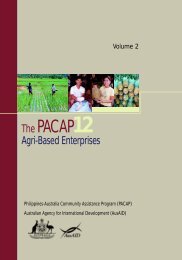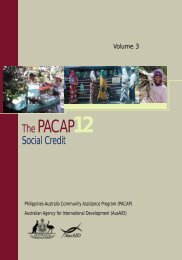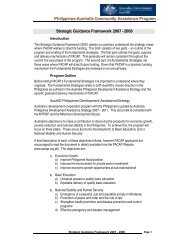The PACAP12
The PACAP12
The PACAP12
You also want an ePaper? Increase the reach of your titles
YUMPU automatically turns print PDFs into web optimized ePapers that Google loves.
Mt. Matutum Integrated Conservation and Development (MICADEV) Project<br />
hectares through protection, assisted natural regeneration (ANR), reforestation,<br />
agro-forestry, river bank rehabilitation, stabilisation, and gully tree planting.<br />
• To provide basic social services (health and education) to barangay households.<br />
• To provide infrastructure support to community development programs within<br />
MMPL, adjacent areas and the 14 barangays covering the MMPL.<br />
• To develop and implement a coordinated development plan for MMPL and its<br />
adjacent communities in partnership with different stakeholders in the area.<br />
VII. Implementing the Area-Focus<br />
Approach<br />
Basic to the implementation of the MICADEV-AFA project was the<br />
area-focused approach. AFA 11 was a management and implementation<br />
strategy that sought to unite stakeholders with common<br />
and/or complementary agenda, and focus their development<br />
initiatives and resources on a single geographically contiguous<br />
and clearly delineated area.<br />
LGU Support. MICADEV was able to harness the resources<br />
and support of affected barangays, municipalities, and<br />
provinces in the MMPL initiative. LGU officials showed<br />
ready support for the program. Having seen their people<br />
suffer the effects of calamitous floods and continued water<br />
depletion, they were optimistic that MICADEV could avert the recurrence of such<br />
calamities. <strong>The</strong> LGUs put counterpart funding and other resources at the disposal of<br />
the project. <strong>The</strong> LGUs also issued resolutions, ordinances, and executive orders to<br />
provide a legal mandate to support MICADEV activities.<br />
Multi-Sectoral/Multi-Level Coordination. <strong>The</strong> AFA approach implied close coordination<br />
among key development players, especially between and among developmental<br />
NGOs and LGUs. <strong>The</strong>matic or sectoral concerns like environment, gender development<br />
and women’s concerns, ecologically sound agricultural, indigenous peoples’<br />
(IP) concerns, and others, were all incorporated into educational and social awareness-raising<br />
activities and in the processes for implementing specific project components<br />
under MICADEV.<br />
Learning Process Focus To Project Management, Evaluation and Monitoring. AFA<br />
used a learning process approach wherein project accomplishments, positive<br />
changes, and transformation in one area would lend insight and learning to project<br />
implementation in other areas. This learning approach also helped to rationalise<br />
decisions related to expansion or replication of project initiatives to new areas.<br />
11 In some sectors, the AFA strategy is known as “convergence”, where resources from various sectors are<br />
concentrated on a priority area where problems are at such a level of urgency, magnitude and complexity as<br />
to require concerted multi-sectoral action. A similar approach was being implemented in Agrarian Reform<br />
Communities, although on a much smaller scale.<br />
B E S T P R A C T I C E S I N C O M M U N I T Y D E V E L O P M E N T 29







